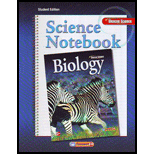
To compare:
The zones of lakes and ponds by completing the given table.
Introduction:
Major freshwater ecosystems are ponds, lakes, streams, rivers and wetlands. An inland body of standing water is called a lake or a pond. Some ponds have water for few weeks or months each year while some lakes have water for hundreds of years. Mixing of the warm and cold water from top and bottom layers of lake results in uniform temperature of water. This mixing circulates oxygen and nutrients.
Answer to Problem 6MI
| Zone | Location | Example Species |
| Limnetic | Well- lit open water area | Plankton and many species of fish |
| Profundal | Deepest areas of a large lake | Limited due to cold and reduced light and oxygen |
| Littoral | Closest to shore | Algae, rooted and floating plants, insects, clams, fishes, amphibians, crustaceans and snails |
Explanation of Solution
Lakes and ponds are divided into three zones based on the amount of sunlight that penetrate the water.
- The area closest to the shore is called the littoral zone. The water in this zone is shallow and allows sunlight to reach the bottom. Many producers like aquatic plants and algae, live in these shallow waters. This is the area of high photosynthesis. Many consumers like frogs, turtles, worms, crustaceans, insect larvae, and fish also live here.
- The limnetic zone is the open water area that is well lit and is dominated by plankton. Planktons are free- floating photosynthetic autotrophs that live in marine and fresh water ecosystems. Many species of fish also live here because food (planktons) is readily available.
- The water of the profundal zone is deepest areas of a large lake. It is much colder and low in oxygen content. Very little light is able to penetrate the limnetic zone to reach this zone thereby, limiting the growth of species here.
Additional Science Textbook Solutions
Campbell Biology (10th Edition)
Brock Biology of Microorganisms (15th Edition)
Human Biology: Concepts and Current Issues
Campbell Essential Biology (6th Edition) - standalone book
Campbell Biology (11th Edition)
Genetic Analysis: An Integrated Approach (3rd Edition)
 Human Anatomy & Physiology (11th Edition)BiologyISBN:9780134580999Author:Elaine N. Marieb, Katja N. HoehnPublisher:PEARSON
Human Anatomy & Physiology (11th Edition)BiologyISBN:9780134580999Author:Elaine N. Marieb, Katja N. HoehnPublisher:PEARSON Biology 2eBiologyISBN:9781947172517Author:Matthew Douglas, Jung Choi, Mary Ann ClarkPublisher:OpenStax
Biology 2eBiologyISBN:9781947172517Author:Matthew Douglas, Jung Choi, Mary Ann ClarkPublisher:OpenStax Anatomy & PhysiologyBiologyISBN:9781259398629Author:McKinley, Michael P., O'loughlin, Valerie Dean, Bidle, Theresa StouterPublisher:Mcgraw Hill Education,
Anatomy & PhysiologyBiologyISBN:9781259398629Author:McKinley, Michael P., O'loughlin, Valerie Dean, Bidle, Theresa StouterPublisher:Mcgraw Hill Education, Molecular Biology of the Cell (Sixth Edition)BiologyISBN:9780815344322Author:Bruce Alberts, Alexander D. Johnson, Julian Lewis, David Morgan, Martin Raff, Keith Roberts, Peter WalterPublisher:W. W. Norton & Company
Molecular Biology of the Cell (Sixth Edition)BiologyISBN:9780815344322Author:Bruce Alberts, Alexander D. Johnson, Julian Lewis, David Morgan, Martin Raff, Keith Roberts, Peter WalterPublisher:W. W. Norton & Company Laboratory Manual For Human Anatomy & PhysiologyBiologyISBN:9781260159363Author:Martin, Terry R., Prentice-craver, CynthiaPublisher:McGraw-Hill Publishing Co.
Laboratory Manual For Human Anatomy & PhysiologyBiologyISBN:9781260159363Author:Martin, Terry R., Prentice-craver, CynthiaPublisher:McGraw-Hill Publishing Co. Inquiry Into Life (16th Edition)BiologyISBN:9781260231700Author:Sylvia S. Mader, Michael WindelspechtPublisher:McGraw Hill Education
Inquiry Into Life (16th Edition)BiologyISBN:9781260231700Author:Sylvia S. Mader, Michael WindelspechtPublisher:McGraw Hill Education





